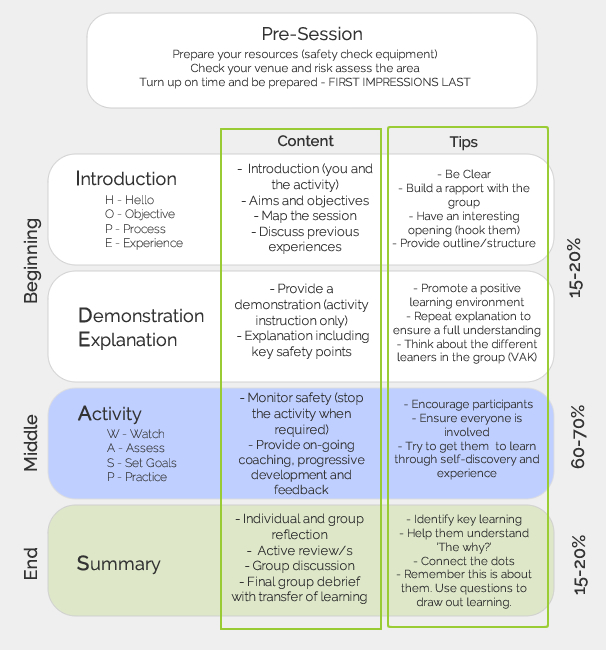
Trying to teach a team building or activity session without planning is like heading cross country without a map. You can do it, but it is rarely an efficient way to travel and you will likely end up getting lost. Understanding session structure is essential because it gives you a clear sense of what you are trying to accomplish and how you are going to accomplish it.
The aim of this article is to provide you with a few of the different models I use when I train new instructors and facilitators how to teach a team development workshop or activity session for the first time.
The models and techniques suggested are tried and tested; they draw on my research, learning, and my experience as an instructor over the past twelve years. These models can be used and adapted to suit most session types including team building, experiential learning, and activity sessions.
Once you become more experienced you will stray away from these delivery models and think about new ways to deliver your sessions. These models do, however, provide a simple starting point that will set you on the right path and give you confidence when teaching for the first time.
How to Structure a Session?
I like to think of the structure of a good session, in the same way a book is written. Like an enjoyable read, a good session has a natural flow to it, it also has structure, variations in pace, loudness, moments of silence, periods of reflection, and periods of action.
In your sessions, as in stories, there should be a smooth transition from and links between one passage and the next. There should be no moments when the session isn’t moving forward. When you are creating a session plan, you are in a sense writing a story (or piece) to suit your learners and their needs.
Your session will consist of the three following elements: a beginning, a middle, and an end; or introduction, activity, and summary.
Still with me? Great, I’ll examine, the important elements of each stage in detail.
Understanding the Model – I.D.E.A.S
Beginning – Introduction
All lessons need introductions where objectives and expectations are shared. Here the scene is set and the lesson is located in the context of previous and future learning. Participants should be helped to see the ‘big picture’.
Introductions should be kept short, but be sure to allow enough time. If you are working with the group for the first time, remember to introduce yourself. You need to explain objectives and expected outcomes briefly at the beginning of each subsequent episode.
Like a good storyteller, you should try to hook the group immediately. First impressions last and a well-planned and well-delivered introduction will set the tone for the whole session.
The opening of a session, particularly the first time you meet a group of learners, may be referred to as the ‘establishment phase’ or ‘framing’.
Introduce the activity by making it clear what it is about, what they are going to do, why they are doing it, and how it fits within their programme (explain the ‘why’). There should always be an introduction or a starting point to a session, even if it’s a workshop or practical session.
If the group has had a similar experience in the past, discuss this with them and build on that experience.
A good way of remember all these key points for the introduction is to use: HOPE
H – Hello (Introduce yourself and the activity)
O – Objective (Session objectives, aims, and why they’re doing it)
P – Process (Map the session – what they’ll be doing?)
E – Experience (Discuss and build on previous experiences)
Beginning – Demonstration and Explanation
If you are delivering a skill based activity, then you will need to provide some form of visual demonstration for participants.
You should always provide an overview and explanation of the activity as well as any safety points the participants should be made aware of. The initial explanation may be very brief and confined to a description. When teaching an activity-specific session, you should include this as part of your demonstration.
A good strategy would be to organise the group into a semicircle, so everyone can see. Any demonstration should be kept brief, in order to allow participants as much time as possible on the activity.
Do a visual demonstration and provide an explanation of what you are doing step-by-step. Once you have done that, re-do the demonstration but silently (without the explanation). Follow up by using a question-and-answer strategy, this helps check the group’s understanding and is also engaging for learners.
If you are teaching a team building session, you can alternatively hand the group a printed challenger brief and let them begin. Just be sure to reiterate the safety points and timings.
For printable team-building challenger briefs and leader notes, please purchase my team building activity book (PDF download) for $19.99. The book features over 30 of the best team development activities on-site with full instructions, ready-to-use programmes, and easy step-by-step guidelines to help you deliver a successful team event.
Middle – Activity (Learning by Doing)
This is where the content is delivered, the objectives met and, most importantly, the participants learn. Effective learning uses a variety of teaching and learning techniques which are clearly structured and timed with smooth and seamless transitions between them.
It is important to estimate and plan the length of time needed for activities and share this with the group. They will lose focus and motivation if activities are not timed and just seem to drift to a vague conclusion.
The majority of your session time should be allocated to the activity (time on task). Typically, new instructors/facilitators should aim for 60-70% of their session time allocated for the activity. This will vary according to your learners and the time you have, this is by no means a formula that has to be rigidly adhered to – if all learners seem to be involved and interested then it’s acceptable to continue with the activity.
Reflective practitioners recognise the signs which indicate when it’s time for something new or to break up the session. Careful planning helps you to manage the transitions smoothly without any gaps or periods of inactivity.
Research suggests that learners enjoy active participation and don’t appreciate inactivity. Some learners who present challenging behaviour and poor motivation might exploit any gaps in the session to behave inappropriately.
Your planning should ensure that the main body of your sessions allows for regular checks on learning and opportunities for people to show what they have learned.
When they are in activity, you should observe and offer corrective feedback on an individual basis to improve performance. If more than a couple of people are making the same mistake, stop the group and revisit the demonstration, and reinforce the key coaching points. For a typical taster session, an introduction to the activity, some basic coaching, and an opportunity to experience the activity are enough.
Here is enough model, which may be of use whilst teaching – it can be used for both activity and team building sessions.
W – Watch (Observe the participants and monitor for safety)
A – Assess (Identify any areas of improvement and offer feedback)
S – Set Goals (Following feedback, set them a new target or aim for the session)
P – Practice (Allow them time to practice and to learn through experience)
End – Summary
It is here that learning is reviewed and there is an opportunity to reflect on the learning process itself. These periods may be short (5 to 15 minutes) depending on how much time you have available. An alternative would be to do a number of shorter reviews throughout the session to help teams recognize progressive development and set new goals.
This ending should round off the whole session and bring it to a clear conclusion. Some sessions just fade, away without any real review of the learning or indication of what will happen next; others just stop suddenly unannounced, rather like falling off a cliff. A review is essential to help participants clarify their learning, connect the dots, and think about how these skills can be applied in the future.
The elements of a good ending include:
– Reviewing learning objectives (Set at the start of the activity)
– A review to help look back on the experience and identify learning
– An opportunity for participants to reflect on the session
– Transfer of learning: a link to the learning whether direct or indirect (how can they use the skills learned)
– prompt finish on time – you may wish to thank learners for their attention and efforts.
To understand reviewing, reflection, and a list of reviewing methods, check out the reviewing section of the site.
Learning through experience and evaluation
A good leader always evaluates a session that they have led (this is known as reflection on action). The evaluation of a session helps to highlight what was successful about the session as well as what can be improved.
The evaluation should be carried out as soon as possible, ideally after the session has been completed so that key information and learning are not lost for the planning of the following session. You should allow time to reflect and get feedback from participants. All information, whether good or bad, should be used to build on your success and ensure your next session is better.




